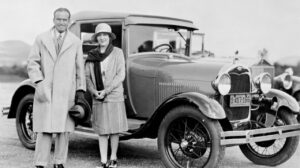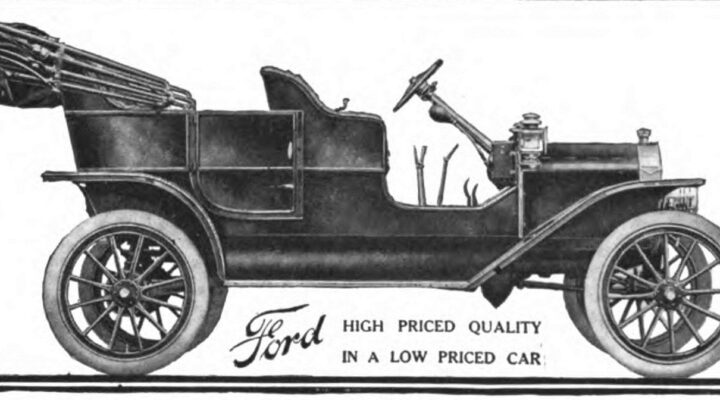Henry Ford’s influence on the automobile industry and, through it, much of modern history is well known.
Most people probably could tell you that Ford and his employees perfected the assembly-line method of producing automobiles. It is demonstrably true that he was innovative and that his genius for building cars and making them available to even the poorest American family created monumental change.

Bob Newell
His Model T rolled out in late 1918 and in just 10 years accounted for one-half of all vehicles on America’s developing streets and highways. Ford astonished the world in 1914 by offering a $5 per day wage ($140 today), which more than doubled the pay of most of his workers.
He located the steering wheel on the left and his competitors soon copied. The engine and transmission were enclosed; the four cylinders were cast in a solid block; the suspension used two semi-elliptic springs. Henry’s car was quite simple to drive and easy and cheap to repair.
Purchasing it was so cheap at $825 in 1908, with the price falling every year, that by the 1920s, a majority of American drivers had learned to drive on the Model T, despite the fact that drivers who were only familiar with the Model T’s unique transmission and steering-column operated throttle/accelerator had to learn a completely different set of skills to drive any other gasoline-powered automobile of the era.
A man of strong opinions, Ford also is remembered for his infamous resistance to offering automobiles in a variety of colors. In his autobiography, he said: “Any customer can have a car painted any color he wants so long as it is black.”He was a noted pacifist, anti-union, and by all accounts, unafraid of going against “conventional wisdom.” He often countermanded his engineers and his own son to whom he had, at least in theory, relinquished the running of his successful company. He was notoriously resistant to changing the ever-popular Model T, even when it became apparent that his simple machine was rapidly outpaced by newer auto developments.
By the mid-1920s, the dominance of the Model T was beginning to slide, largely through the popularity of the more “modern” Chevrolet from General Motors, Ford’s chief competitor. Reluctantly, the strong-minded Ford finally agreed with his son, Edsel, and authorized the production of what would become the Ford Model A.

Actors Doug Fairbanks and Mary Pick with a 1928 Ford Model A Sport Coupe (Ford Motor Co.)
But here is an apparently true and interesting tidbit: When photographers asked Henry Ford to drive the first new-fangled Model A off the assembly line, he was forced to decline, since he had never driven a standard-shift car. His baby, the Model T, utilized a unique foot operated planetary transmission and he could not drive the newer model.
I’ve been thinking about that and have concluded Henry Ford and I have much in common. No, I am not an automobile designer or even a mechanic. But Henry and I (you, too) are alike in the way that every human being is alike. No matter how brilliant and innovative we may be, each one of us must always make way for younger, smarter and more advanced levels of thinking as we age.
As my body’s odometer is beginning to knock on the door of my eighth decade, and my “tires” (actually my head) grow balder by the day, I live with the reality that some of my thinking needs to be replaced by, or at least enhanced by or accommodated to, the more advanced thinking of those younger than myself.
I “know” that much I “know” is not outdated and never will change. Matters of the Spirit and the truth of God’s word do not change with the years.
But I also “know,” from personal experience, that I always need to adjust to the ways I understand and apply those immutable truths. I must make room for some, not all, of the latest ideas and the thoughts of those who have come along after me.
“I often have benefitted from the opinions, creativity, partnership, out-of-my-box-thinking, courage and innovation of those who are much younger than me and who once were my students.”
Having had the privilege of working, for instance, with generations of young ministers since the late 1960s, I often have benefitted from the opinions, creativity, partnership, out-of-my-box-thinking, courage and innovation of those who are much younger than me and who once were my students. Some of my favorite memories, as an undergraduate professor, were those advanced-level classes in which the students were encouraged to discuss, disagree with or question, rather than simply regurgitate my lectures.
As an educator, I have learned those younger persons with whom I interact are not “woefully empty vessels,” needing to be “filled” by the vast and superior knowledge which I, alone, can impart. No, indeed! All of us, teacher and student, are learners and often I benefit from the newer learnings and more up-to-date life experiences of those with whom I am privileged to be a co-learner.
While a diversity of life experiences and viewpoints can make learning more complicated, they also may make learning more rich, more contemporary and more fulfilling for all concerned, the youngsters and even the oldsters like me.
Bob Newell has served as a university professor and administrator, a local church pastor and a cross-cultural missionary. He and his wife, Janice, now live in Georgetown, Texas, and he serves churches as transition coach and intentional interim pastor. They were the founders and remain advocates of PORTA, the Albania House in Athens, Greece.
Related articles:
Change is good — except when it isn’t | Opinion by Erich Bridges
‘Spiritual vitality’ and willingness to change on the rise in U.S. congregations
Change is inevitable. Transformation is optional | Opinion by Amy Butler


